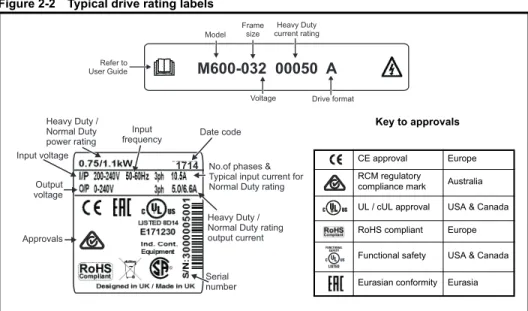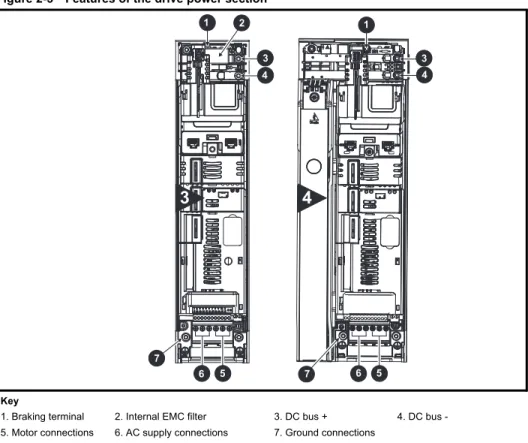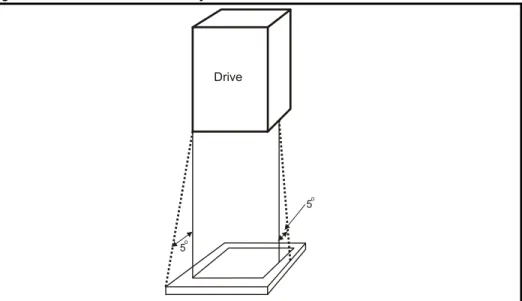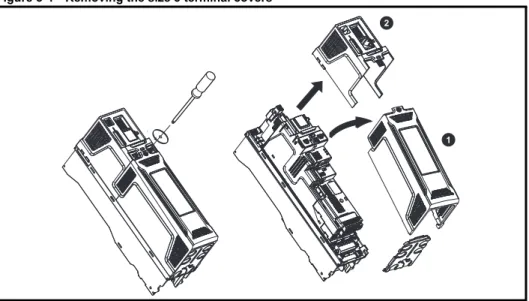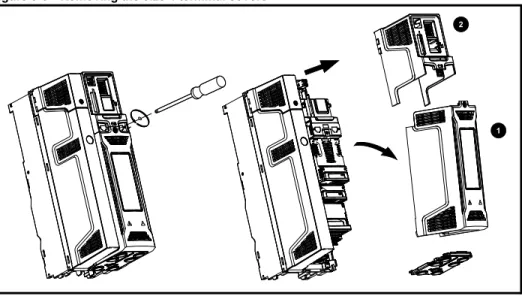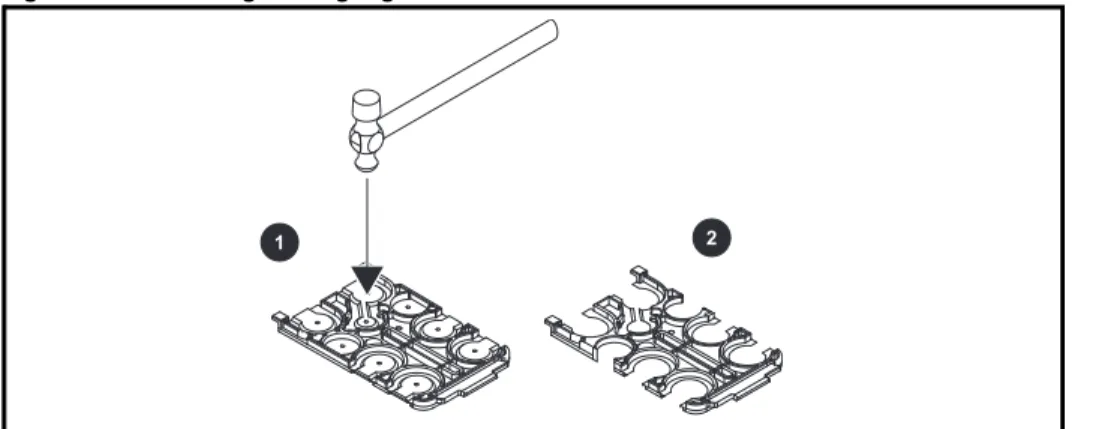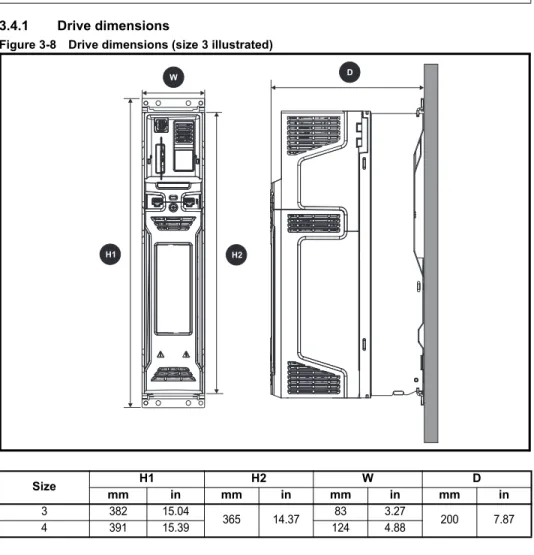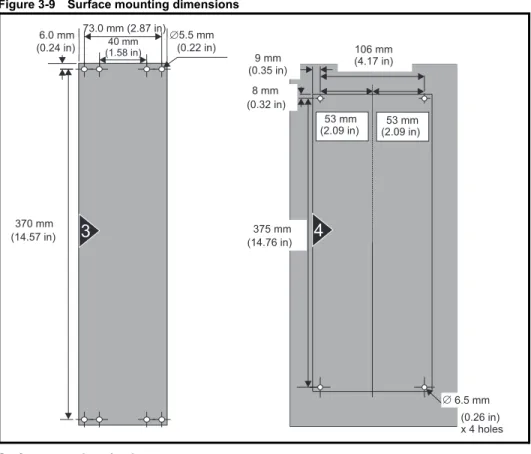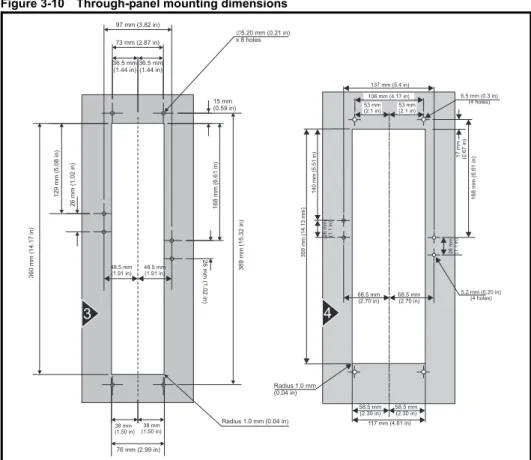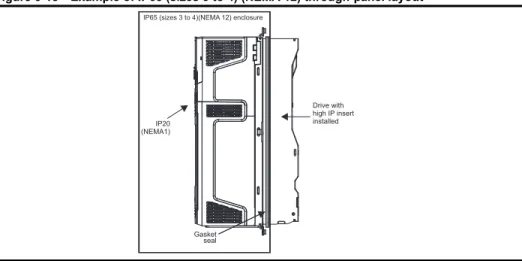Frame 3 to 4
Power Installation Guide
Unidrive M600 to M702 and HS70 to HS72
Part Number: 0478-0254-07
Original Instructions
For the purposes of compliance with the EU Machinery Directive 2006/42/EC, the English version of this manual is the Original Instructions. Manuals in other languages are Translations of the Original Instructions.
Documentation
Manuals are available to download from the following locations: http://www.drive-setup.com/ctdownloads The information contained in this manual is believed to be correct at the time of printing and does not form part of any contract. The manufacturer reserves the right to change the specification of the product and its performance, and the contents of the manual, without notice.
Warranty and Liability
In no event and under no circumstances shall the manufacturer be liable for damages and failures due to misuse, abuse, improper installation, or abnormal conditions of temperature, dust, or corrosion, or failures due to operation outside the published ratings. The manufacturer is not liable for consequential and incidental damages.
Contact the supplier of the dive for full details of the warranty terms.
Environmental policy
Control Techniques Ltd operates an Environmental Management System (EMS) that conforms to the International Standard ISO 14001.
Further information on our Environmental Policy can be found at: http://www.drive-setup.com/environment Restriction of Hazardous Substances (RoHS)
The products covered by this manual comply with European and International regulations on the Restriction of Haz- ardous Substances including EU directive 2011/65/EU and the Chinese Administrative Measures for Restriction of Hazardous Substances in Electrical and Electronic Products.
Disposal and Recycling (WEEE)
REACH legislation
EC Regulation 1907/2006 on the Registration, Evaluation, Authorisation and restriction of Chemicals (REACH) requires the supplier of an article to inform the recipient if it contains more than a specified proportion of any substance which is considered by the European Chemicals Agency (ECHA) to be a Substance of Very High Concern (SVHC) and is therefore listed by them as a candidate for compulsory authorisation.
Further information on our compliance with REACH can be found at: http://www.drive-setup.com/reach Registered Office
Nidec Control Techniques Ltd The Gro
Newtown Powys SY16 3BE
UKRegistered in England and Wales. Company Reg. No. 01236886.
When electronic products reach the end of their useful life, they must not be disposed of along with domestic waste but should be recycled by a specialist recycler of electronic equipment.
Control Techniques products are designed to be easily dismantled into their major component parts for efficient recycling. The majority of materials used in the product are suitable for recycling.
Product packaging is of good quality and can be re-used. Large products are packed in wooden crates. Smaller products are packaged in strong cardboard cartons which have a high recycled fibre content. Cartons can be re-used and recycled. Polythene, used in protective film and bags for wrapping the product, can be recycled. When preparing to recycle or dispose of any product or packaging, please observe local legislation and best practice.
Copyright
The contents of this publication are believed to be correct at the time of printing. In the interests of a commitment to a policy of continuous development and improvement, the manufacturer reserves the right to change the specification of the product or its performance, or the contents of the guide, without notice.
All rights reserved. No parts of this guide may be reproduced or transmitted in any form or by any means, electrical or mechanical including photocopying, recording or by an information storage or retrieval system, without permission in writing from the publisher.
Copyright © January 2020 Nidec Control Techniques Ltd
Contents
1 Safety information ...9
1.1 Warnings, Cautions and Notes ...9
1.2 Important safety information. Hazards. Competence of designers and installers ....9
1.3 Responsibility ...9
1.4 Compliance with regulations ...9
1.5 Electrical hazards ...10
1.6 Stored electrical charge ...10
1.7 Mechanical hazards ...10
1.8 Access to equipment ...10
1.9 Environmental limits ...10
1.10 Hazardous environments ...11
1.11 Motor ...11
1.12 Mechanical brake control ...11
1.13 Adjusting parameters ...11
1.14 Electromagnetic compatibility (EMC) ...11
2 Product information ...12
2.1 Introduction ...12
2.2 Model number ...12
2.3 Nameplate description ...13
2.4 Ratings ...14
2.5 Drive features ...16
2.6 Items supplied with the drive ...17
3 Mechanical installation ...18
3.1 Safety information ...18
3.2 Planning the installation ...19
3.3 Terminal cover removal ...21
3.4 Dimensions and mounting methods ...24
3.5 Enclosure for standard drives ...28
3.6 Enclosure design and drive ambient temperature ...33
3.7 Heatsink fan operation ...33
3.8 Enclosing standard drive for high environmental protection ...33
3.9 Installation of high IP insert for size 3 and 4 ...35
3.10 Size 3 and 4 internal braking resistor ...38
3.11 External EMC filter ...42
3.12 Terminal size and torque settings ...44
3.13 Routine maintenance ...45
4 Electrical installation ...46
4.1 Power and ground connections ...47
4.2 AC Supply requirements ...49
4.3 Supplying the drive with DC ...51
4.4 DC bus paralleling ...52
4.5 24 Vdc supply ...53
4.6 Low voltage operation ...54
4.7 Fan power supply ...54
4.8 Ratings ...54
4.9 Output circuit and motor protection ...55
4.10 Braking ...58
4.11 Ground leakage ...63
4.12 EMC (Electromagnetic compatibility) ...64
5 Technical data ...77
5.1 Drive technical data ...77
5.2 Optional external EMC filters ...97
6 UL lnformation ...99
6.1 UL file reference ... 99
6.2 Option modules, kits and accessories ... 99
6.3 Enclosure ratings ... 99
6.4 Mounting ... 99
6.5 Environment ... 100
6.6 Electrical Installation ... 100
6.7 Motor overload protection and thermal memory retention ... 101
6.8 External Class 2 supply ... 101
6.9 Modular Drive Systems ... 101
Declaration of Conformity
This declaration applies to the Unidrive M/HS product range comprising model numbers listed below:
The model number may be followed by additional characters that do not affect the ratings.
The variable speed drive products listed above have been designed and manufactured in accordance with the following European harmonized standards:
EN 61000-3-2: 2006 Applicable where input current < 16 A. No limits apply for professional equipment where input power 1 kW.
These products comply with the Restriction of Hazardous Substances Directive - RoHS 2011/65/EU, the Low Voltage Directive - LVD 2006/95/EC and the Electromagnetic Compatibility Directive - EMC 2004/108/EC.
These electronic drive products are intended to be used with appropriate motors, controllers, electrical protection components and other equipment to form complete end products or systems. Compliance with safety and EMC regulations depends upon installing and configuring drives correctly, including using the specified input filters. The drives must be installed only by professional installers who are familiar with requirements for safety and EMC. The assembler is responsible for ensuring that the end product or system complies with all the relevant laws in the country where it is to be used. Refer to the Product Documentation. An EMC data sheet is also available giving detailed EMC information.
Control Techniques Ltd The Gro
Newtown Powys UK SY16 3BE
Model
number Interpretation Nomenclature aaaa - bbc ddddde
X Application M = Manufacturing Automation, E = Elevator, F = Flow, H = HVAC, CSD = Compressor, EVC = Emerson Variable Scroll, HS = High Speed
aaaa Basic series M100, M101, M200, M201, M300, M400, M600, M700, M701, M702, F300, H300, E200, E300, CSD1, HS30, HS70, HS71, HS72, M000, RECT bb Frame size 01, 02, 03, 04, 05, 06, 07, 08, 09, 10, 11
c Voltage rating 1 = 100 V, 2 = 200 V, 4 = 400 V, 5 = 575 V, 6 = 690 V ddddd Current rating Example 01000 = 100 A
e Drive format A = 6P Rectifier + Inverter (internal choke), D = Inverter, E = 6P Rectifier + Inverter (external choke), N = 18P Rectifier + Inverter, T = 12P Rectifier + Inverter
EN 61800-5-1:2007 Adjustable speed electrical power drive systems - Part 5-1: Safety requirements - Electrical, thermal and energy
EN 61800-3: 2004 Adjustable speed electrical power drive systems - Part 3: EMC requirements and specific test methods
EN 61000-6-2:2005 Electromagnetic compatibility (EMC) - Part 6-2: Generic standards - Immunity for industrial environments
EN 61000-6-4:2007 Electromagnetic compatibility (EMC) - Part 6-4: Generic standards - Emission standard for industrial environments
EN 61000-3-2:2006 Electromagnetic compatibility (EMC) - Part 3-2: Limits for harmonic current emissions (equipment input current ≤16 A per phase)
EN 61000-3-3:2008 Electromagnetic compatibility (EMC) - Part 3-3: Limitation of voltage changes, voltage fluctuations and flicker in public, low voltage supply systems, for equipment with rated current ≤16 A per phase and not subject to conditional connection
G Williams
Vice President, Technology Date: 30th November 2015
Declaration of Conformity (including 2006 Machinery Directive)
This declaration applies to the Unidrive M/HS product range comprising model numbers listed below:
The model number may be followed by additional characters that do not affect the ratings.
This declaration relates to these products when used as a safety component of a machine. Only the Safe Torque Off function may be used for a safety function of a machine. None of the other functions of the drive may be used to carry out a safety function.
These products fulfil all the relevant provisions of the Machinery Directive 2006/42/EC and the EMC Directive 2014/
108/EC.
EC type examination has been carried out by the following notified body:
TUV Rheinland Industrie Service GmbH Am Grauen Stein
D-51105 Köln Germany
Notified body identification number: 0035 The harmonized standards used are shown below:
EC type-examination certificate numbers:
01/205/5270.01/14 dated 2014-11-11 01/205/5387.01/15 dated 2015-01-29 01/205/5383.02/15 dated 2015-04-21 Control Techniques Ltd
The Gro Newtown Powys UK SY16 3BE
Model
number Interpretation Nomenclature aaaa - bbc ddddde
X Application M = Manufacturing Automation, E = Elevator, F = Flow, H = HVAC, CSD = Compressor, EVC = Emerson Variable Scroll, HS = High Speed
aaaa Basic series M300, M400, M600, M700, M701, M702, F300, H300, E200, E300, CSD1, HS30, HS70, HS71, HS72, M000, RECT
bb Frame size 01, 02, 03, 04, 05, 06, 07, 08, 09, 10, 11
c Voltage rating 1 = 100 V, 2 = 200 V, 4 = 400 V, 5 = 575 V, 6 = 690 V ddddd Current rating Example 01000 = 100 A
e Drive format A = 6P Rectifier + Inverter (internal choke), D = Inverter, E = 6P Rectifier + Inverter (external choke), N = 18P Rectifier + Inverter, T = 12P Rectifier + Inverter
EN 61800-5-1:2007 Adjustable speed electrical power drive systems - Part 5-1: Safety requirements - Electrical, thermal and energy
EN 61800-5-2:2007 Adjustable speed electrical power drive systems - Part 5-2: Safety requirements - Functional
EN ISO 13849-1:2008 Safety of Machinery, Safety-related parts of control systems, General principles for design
EN ISO 13849-2:2008 Safety of machinery, Safety-related parts of control systems. Validation EN 61800-3: 2004 Adjustable speed electrical power drive systems - Part 3: EMC requirements and
specific test methods
Person authorised to complete the technical file:
C Hargis Chief Engineer Newtown, Powys, UK
IMPORTANT NOTICE
These electronic drive products are intended to be used with appropriate motors, controllers, electrical protection components and other equipment to form complete end products or systems. It is the responsibility of the installer to ensure that the design of the complete machine, including its safety-related control system, is carried out in accordance with the requirements of the Machinery Directive and any other relevant legislation. The use of a safety-related drive in itself does not ensure the safety of the machine.
Compliance with safety and EMC regulations depends upon installing and configuring drives correctly, including using the specified input filters. The drive must be installed only by professional installers who are familiar with requirements for safety and EMC. The assembler is responsible for ensuring that the end product or system complies with all relevant laws in the country where it is to be used. For more information regarding Safe Torque Off, refer to the Control User Guide.
G Williams
Vice President, Technology Date: 30th November 2015
Safety informationProduct informationMechanical installationElectrical installationTechnical dataUL
1 Safety information
1.1 Warnings, Cautions and Notes
1.2 Important safety information. Hazards. Competence of designers and installers
This guide applies to products which control electric motors either directly (drives) or indirectly (controllers, option modules and other auxiliary equipment and accessories). In all cases the hazards associated with powerful electrical drives are present, and all safety information relating to drives and associated equipment must be observed.
Specific warnings are given at the relevant places in this guide.
Drives and controllers are intended as components for professional incorporation into complete systems. If installed incorrectly they may present a safety hazard. The drive uses high voltages and currents, carries a high level of stored electrical energy, and is used to control equipment which can cause injury. Close attention is required to the electrical installation and the system design to avoid hazards either in normal operation or in the event of equipment malfunction. System design, installation, commissioning/start-up and maintenance must be carried out by personnel who have the necessary training and competence. They must read this safety information and this guide carefully.
1.3 Responsibility
It is the responsibility of the installer to ensure that the equipment is installed correctly with regard to all instructions given in this guide. They must give due consideration to the safety of the complete system, so as to avoid the risk of injury both in normal operation and in the event of a fault or of reasonably foreseeable misuse.
The manufacturer accepts no liability for any consequences resulting from inappropriate, negligent or incorrect installation of the equipment.
1.4 Compliance with regulations
The installer is responsible for complying with all relevant regulations, such as national wiring regulations, accident prevention regulations and electromagnetic compatibility (EMC) regulations.
Particular attention must be given to the cross-sectional areas of conductors, the selection of fuses or other protection, and protective ground (earth) connections.
This guide contains instructions for achieving compliance with specific EMC standards.
All machinery to be supplied within the European Union in which this product is used must comply with the following directives:
A Warning contains information which is essential for avoiding a safety hazard.
A Caution contains information which is necessary for avoiding a risk of damage to the product or other equipment.
A Note contains information, which helps to ensure correct operation of the product.
WARNING
CAUTION
NOTE
1.5 Electrical hazards
The voltages used in the drive can cause severe electrical shock and/or burns, and could be lethal.
Extreme care is necessary at all times when working with or adjacent to the drive. Hazardous voltage may be present in any of the following locations:
• AC and DC supply cables and connections
• Output cables and connections
• Many internal parts of the drive, and external option units
Unless otherwise indicated, control terminals are single insulated and must not be touched.
The supply must be disconnected by an approved electrical isolation device before gaining access to the electrical connections.
The STOP and Safe Torque Off functions of the drive do not isolate dangerous voltages from the output of the drive or from any external option unit.
The drive must be installed in accordance with the instructions given in this guide. Failure to observe the instructions could result in a fire hazard.
1.6 Stored electrical charge
The drive contains capacitors that remain charged to a potentially lethal voltage after the AC supply has been disconnected. If the drive has been energized, the AC supply must be isolated at least ten minutes before work may continue.
1.7 Mechanical hazards
Careful consideration must be given to the functions of the drive or controller which might result in a hazard, either through their intended behaviour or through incorrect operation due to a fault. In any application where a malfunction of the drive or its control system could lead to or allow damage, loss or injury, a risk analysis must be carried out, and where necessary, further measures taken to reduce the risk - for example, an over-speed protection device in case of failure of the speed control, or a fail-safe mechanical brake in case of loss of motor braking.
With the sole exception of the Safe Torque Off function, none of the drive functions must be used to ensure safety of personnel, i.e. they must not be used for safety-related functions.
The Safe Torque Off function may be used in a safety-related application. The system designer is responsible for ensuring that the complete system is safe and designed correctly according to the relevant safety standards.
The design of safety-related control systems must only be done by personnel with the required training and experience. The Safe Torque Off function will only ensure the safety of a machine if it is correctly incorporated into a complete safety system. The system must be subject to a risk assessment to confirm that the residual risk of an unsafe event is at an acceptable level for the application.
1.8 Access to equipment
Access must be restricted to authorized personnel only. Safety regulations which apply at the place of use must be complied with.
1.9 Environmental limits
Instructions in this guide regarding transport, storage, installation and use of the equipment must be complied with, including the specified environmental limits. This includes temperature, humidity, contamination, shock and vibration. Drives must not be subjected to excessive physical force.
Safety informationProduct informationMechanical installationElectrical installationTechnical dataUL
1.10 Hazardous environments
The equipment must not be installed in a hazardous environment (i.e. a potentially explosive environment).
1.11 Motor
The safety of the motor under variable speed conditions must be ensured.
To avoid the risk of physical injury, do not exceed the maximum specified speed of the motor.
Low speeds may cause the motor to overheat because the cooling fan becomes less effective, causing a fire hazard. The motor should be installed with a protection thermistor. If necessary, an electric forced vent fan should be used.
The values of the motor parameters set in the drive affect the protection of the motor. The default values in the drive must not be relied upon. It is essential that the correct value is entered in the Motor Rated Current parameter.
1.12 Mechanical brake control
Any brake control functions are provided to allow well co-ordinated operation of an external brake with the drive. While both hardware and software are designed to high standards of quality and robustness, they are not intended for use as safety functions, i.e. where a fault or failure would result in a risk of injury. In any application where the incorrect operation of the brake release mechanism could result in injury, independent protection devices of proven integrity must also be incorporated.
1.13 Adjusting parameters
Some parameters have a profound effect on the operation of the drive. They must not be altered without careful consideration of the impact on the controlled system. Measures must be taken to prevent unwanted changes due to error or tampering.
1.14 Electromagnetic compatibility (EMC)
Installation instructions for a range of EMC environments are provided in the relevant Power Installation Guide. If the installation is poorly designed or other equipment does not comply with suitable standards for EMC, the product might cause or suffer from disturbance due to
electromagnetic interaction with other equipment. It is the responsibility of the installer to ensure that the equipment or system into which the product is incorporated complies with the relevant EMC legislation in the place of use.
2 Product information
2.1 Introduction
This guide provides the information necessary to install the following drive models:
Unidrive M600 to M702 frame 3 to 4 Unidrive HS70 to HS72 frame 3 to 4
This guide focuses on the drive power section, for example: electrical installation of the supply / motor cables and mechanical installation of the drive.
For information about the drive control section, for example: parameter set up information, control and encoder connections please refer to the Control User Guide.
2.2 Model number
The model numbers for the Unidrive M/HS product range are formed as illustrated below:
Figure 2-1 Model number
Identification Label Electrical Specifications Derivative
Unidrive M600 Unidrive M700 Unidrive M701 Unidrive M702 Unidrive HS70 Unidrive HS71 Unidrive HS72 Product Line
Frame Size:
Voltage Rating:
Current Rating:
Heavy Duty current rating x 10
Power Format:
Reserved
0
Optional Build Customer Code
01 A B 1 0 0
Customer Code:
00 = 50 Hz 01 = 60 Hz Reserved:
Conformal Coating:
0 = Standard
IP / NEMA Rating:
1 = IP20 / NEMA 1 Brake Transistor:
B = Brake Cooling:
A = Air Documentation
1
Documentation:
0 - Supplied separately 1 - English 2 - French 3 - Italian 4 - German 5 - Spanish 2 - 200 V (200 - 240
- 400 V (380 - 480 - 575 V (500 - 575 - 690 V (500 - 690
±10 %)
4 ±
±
± 10 %)
5 10 %)
6 10 %)
Power Format
M600 - 03 4 00078 A
A - AC in AC out (with internal choke) D - DC in AC out (Inverter) C - AC in DC out (Rectifier) E - AC in AC out (without internal choke) T - AC in AC out (12P rectifier plus inverter)
Safety informationProduct informationMechanical installationElectrical installationTechnical dataUL
2.3 Nameplate description
Figure 2-2 Typical drive rating labels
Date code format
The date code is four numbers. The first two numbers indicate the year and the remaining numbers indicate the week of the year in which the drive was built.
Example:
A date code of 1710 would correspond to week 10 of year 2017.
Refer to User Guide
Model Frame
size
Voltage Heavy Duty current rating
Drive format
M600-032 00050 A
Approvals Input voltage
Output voltage
Heavy Duty / Normal Duty power rating
Date code
Serial number Input
frequency
No.of phases &
Typical input current for Normal Duty rating
Heavy Duty / Normal Duty rating output current 1714
Key to approvals
CE approval Europe RCM regulatory
compliance mark Australia UL / cUL approval USA & Canada RoHS compliant Europe Functional safety USA & Canada Eurasian conformity Eurasia
R
NOTE
2.4 Ratings
The continuous output current ratings given below are for maximum 40 °C (104 °F), 1000 m altitude and 3 kHz switching frequency. Derating is required for higher switching frequencies, ambient temperature >40 °C (104 °F) and high altitude. For further information, refer to Chapter 5Technical dataon page 77.
Table 2-1 200 V drive ratings, cable sizes and fuse ratings
Table 2-2 400 V drive ratings, cable sizes and fuse ratings
* These fuses are fast acting.
Fuses
The AC supply to the drive must be installed with suitable protection against overload and short-circuits. The following section shows recommended fuse ratings. Failure to observe this requirement will cause risk of fire.
Nominal cables sizes below are based on the cable installation method B2 (ref: IEC60364- 5-52:2001) unless otherwise specified, and are provided as a guide only. Ensure cables used suit local wiring regulations.
Model Max.
cont.
input current
Fuse Nominal cable size
Normal Duty Heavy Duty
European USA
IEC UL
Input Output Input Output Max.
cont.
output current
Nom power
@ 230 V
Motor power
@ 230 V
Max.
cont.
output current
Nom power
@ 230 V
Motor power
@ 230 V 3ph Nom
Class Nom Class
A A A mm2 mm2 AWG AWG A kW hp A kW hp
03200050 10.7 16 gG
16 CC, J or T*
1.5 1.5 14 14 6.6 1.1 1.5 5 0.75 1
03200066 13 20 20 1.5 1.5 14 14 8 1.5 2 6.6 1.1 1.5
03200080 17.8 25 25 4 4 12 12 11 2.2 3 8 1.5 2
03200106 20.6 25 25 4 4 12 12 12.7 3 3 10.6 2.2 3
04200137 20.1 25
gG 25 CC, J or T*
6 6 10 10 18 4 5 13.7 3 3
04200185 26.8 32 30 8 8 8 8 25 5.5 7.5 18.5 4 5
Model Max.
cont.
input current
Fuse Nominal cable size
Normal Duty Heavy Duty
European USA
IEC UL
Input Output Input Output Max.
cont.
output current
Nom power
@ 400 V
Motor power
@ 460 V
Max.
cont.
output current
Nom power @ 400 V
Motor power
@ 460 V 3ph Nom
Class Nom Class
A A A mm2 mm2 AWG AWG A kW hp A kW hp
03400025 5 6
gG 10
CC, J or T*
1.5 1.5 18 18 3.4 1.1 1.5 2.5 0.75 1.0
03400031 6.6 10 10 1.5 1.5 16 16 4.5 1.5 2 3.1 1.1 1.5
03400045 9.1 10 10 1.5 1.5 14 14 6.2 2.2 3 4.5 1.5 2.0
03400062 13.1 20 20 2.5 2.5 14 14 7.7 3 5 6.2 2.2 3.0
03400078 13.4 20 20 2.5 2.5 14 14 10.4 4 5 7.8 3 5.0
03400100 15.8 20 20 2.5 2.5 12 12 12.3 5.5 7.5 10 4 5.0
04400150 18.7 25
gG 25 CC, J or T*
4 4 10 10 18.5 7.5 10 15 5.5 10.0
04400172 24.3 32 30 6 6 8 8 24 11 15 17.2 7.5 10.0
Refer to Chapter 5Technical dataon page 77 for maximum fuse rating, maximum cable size and peak currents.
WARNING
NOTE
NOTE
Safety informationProduct informationMechanical installationElectrical installationTechnical dataUL Table 2-3 Protective ground cable ratings
Typical short term overload limits
The maximum percentage overload limit changes depending on the selected motor. Variations in motor rated current, motor power factor and motor leakage inductance all result in changes in the maximum possible overload. Typical values are shown in the table below:
Table 2-4 Typical overload limits
Generally the drive rated current is higher than the matching motor rated current allowing a higher level of overload than the default setting.
The time allowed in the overload region is proportionally reduced at very low output frequency on some drive ratings.
Output current
The continuous output current ratings given on the rating label are for maximum 40 C (104 F), 1000 m altitude and 3 kHz switching frequency. Derating is required for higher switching frequencies, ambient temperatures >40 C (104 F) and higher altitude. For derating information, refer to the Chapter 5Technical dataon page 77.
Input current
The input current is affected by the supply voltage and impedance. The input current given on the rating label is the typical input current and is stated for a balanced supply.
Input phase
conductor size Minimum ground conductor size
≤ 10 mm2 Either 10 mm2 or two conductors of the same cross-sectional area as the input phase conductor
> 10 mm2 and ≤ 16 mm2 The same cross-sectional area as the input phase conductor
> 16 mm2 and ≤ 35 mm2 16 mm2
> 35 mm2 Half of the cross-sectional area of the input phase conductor
Operating mode RFC from cold RFC from 100 % Open loop
from cold Open loop from 100 % Normal Duty overload with motor rated
current = drive rated current 110 % for 165 s 110 % for 9 s 110 % for 165 s 110 % for 9 s Heavy Duty overload with motor rated
current = drive rated current 200 % for 28 s 200 % for 3 s 150 % for 60 s 150 % for 7 s
The maximum overload level which can be attained is independent of the speed.
NOTE
2.5 Drive features
Figure 2-3 Features of the drive power section
Key
1. Braking terminal 2. Internal EMC filter 3. DC bus + 4. DC bus - 5. Motor connections 6. AC supply connections 7. Ground connections
1 2
3 4
6 5 7
1
3 4
6 5 7
Safety informationProduct informationMechanical installationElectrical installationTechnical dataUL
2.6 Items supplied with the drive
The drive is supplied with a copy of the Power Installation Guide and a copy of the Control Getting Started Guide, a safety information booklet, the Certificate of Quality and an accessory kit box including the items shown in Table 2-5.
Table 2-5 Parts supplied with the drive
* Supplied with Unidrive M600 / M700 / M701and HS70 / 71 only.
** Supplied with Unidrive M702 and HS72 only.
Description Size 3 Size 4
Control connectors
(1 to 11 way and 21 to 31 way)
x 1* x 1*
Control connectors (1 to 13)
x 1**
Relay connector
x 1
Grounding bracket
x 1
Surface mounting brackets
x 2 x 2
Grounding clamp
x 1
DC terminal cover grommets
x 2
Supply and motor connector
x 1
3 Mechanical installation
3.1 Safety information
Follow the instructions
The mechanical and electrical installation instructions must be adhered to. Any questions or doubt should be referred to the supplier of the equipment. It is the responsibility of the owner or user to ensure that the installation of the drive and any external option unit, and the way in which they are operated and maintained, comply with the requirements of the Health and Safety at Work Act in the United Kingdom or applicable legislation and regulations and codes of practice in the country in which the equipment is used.
Stored charge
The drive contains capacitors that remain charged to a potentially lethal voltage after the AC supply has been disconnected. If the drive has been energized, the AC supply must be isolated at least ten minutes before work may continue.
Normally, the capacitors are discharged by an internal resistor. Under certain, unusual fault conditions, it is possible that the capacitors may fail to discharge, or be prevented from being discharged by a voltage applied to the output terminals. If the drive has failed in a manner that causes the display to go blank immediately, it is possible the capacitors will not be discharged. In this case, consult Nidec Industrial Automation or their authorized distributor.
Competence of the installer
The drive must be installed by professional assemblers who are familiar with the requirements for safety and EMC. The assembler is responsible for ensuring that the end product or system complies with all the relevant laws in the country where it is to be used.
Enclosure
The drive is intended to be mounted in an enclosure which prevents access except by trained and authorized personnel, and which prevents the ingress of contamination. It is designed for use in an environment classified as pollution degree 2 in accordance with IEC 60664-1. This means that only dry, non-conducting contamination is acceptable.
WARNING
WARNING
WARNING
WARNING
Safety informationProduct informationMechanical installationElectrical installationTechnical dataUL
3.2 Planning the installation
The following considerations must be made when planning the installation:
3.2.1 Access
Access must be restricted to authorized personnel only. Safety regulations which apply at the place of use must be complied with.
The IP (Ingress Protection) rating of the drive is installation dependent. For further information, refer to section 3.8Enclosing standard drive for high environmental protectionon page 33.
3.2.2 Environmental protection
The drive must be protected from:• Moisture, including dripping water or spraying water and condensation. An anti-condensation heater may be required, which must be switched off when the drive is running.
• Contamination with electrically conductive material
• Contamination with any form of dust which may restrict the fan, or impair airflow over various components
• Temperature beyond the specified operating and storage ranges
• Corrosive gasses
3.2.3 Cooling
The heat produced by the drive must be removed without its specified operating temperature being exceeded. Note that a sealed enclosure gives much reduced cooling compared with a ventilated one, and may need to be larger and/or use internal air circulating fans.
For further information, refer to section 3.5Enclosure for standard driveson page 28.
3.2.4 Electrical safety
The installation must be safe under normal and fault conditions. Electrical installation instructions are given in Chapter 4Electrical installation on page 46.
3.2.5 Fire protection
The drive enclosure is not classified as a fire enclosure. A separate fire enclosure must be provided.
For installation in the USA, a NEMA 12 enclosure is suitable.
For installation outside the USA, the following (based on IEC 62109-1, standard for PV inverters) is recommended.
Enclosure can be metal and/or polymeric, polymer must meet requirements which can be
summarized for larger enclosures as using materials meeting at least UL 94 class 5VB at the point of minimum thickness.
Air filter assemblies to be at least class V-2.
The location and size of the bottom shall cover the area shown in Figure 3-1. Any part of the side which is within the area traced out by the 5° angle is also considered to be part of the bottom of the fire enclosure.
During installation it is recommended that the vents on the drive are covered to prevent debris (e.g. wire off-cuts) from entering the drive.
NOTE
Figure 3-1 Fire enclosure bottom layout
The bottom, including the part of the side considered to be part of the bottom, must be designed to prevent escape of burning material - either by having no openings or by having a baffle construction.
This means that openings for cables etc. must be sealed with materials meeting the 5VB requirement, or else have a baffle above. See Figure 3-2 for acceptable baffle construction. This does not apply for mounting in an enclosed electrical operating area (restricted access) with concrete floor.
Figure 3-2 Fire enclosure baffle construction
3.2.6 Electromagnetic compatibility
Variable speed drives are powerful electronic circuits which can cause electromagnetic interference if not installed correctly with careful attention to the layout of the wiring.
Some simple routine precautions can prevent disturbance to typical industrial control equipment.
If it is necessary to meet strict emission limits, or if it is known that electromagnetically sensitive equipment is located nearby, then full precautions must be observed. In-built into the drive, is an internal EMC filter, which reduces emissions under certain conditions. If these conditions are exceeded, then the use of an external EMC filter may be required at the drive inputs, which must be located very close to the drives. Space must be made available for the filters and allowance made for carefully segregated wiring. Both levels of precautions are covered in section 4.12EMC
(Electromagnetic compatibility) on page 64.
3.2.7 Hazardous areas
The drive must not be located in a classified hazardous area unless it is installed in an approved enclosure and the installation is certified.
Drive
5o
5o
N o t l e s s
t h a n 2 X B a f f l e p l a t e s ( m a y b e
a b o v e o r b e l o w b o t t o m o f e n c l o s u r e )
X
B o t t o mo f f i r e e n c l o s u r e
Not less than 2
times ‘X’ Baffle plates (may be above or below bottom of enclosure)
Bottom of fire enclosure X
Safety informationProduct informationMechanical installationElectrical installationTechnical dataUL
3.3 Terminal cover removal
3.3.1 Removing the terminal covers
Figure 3-3 Location and identification of terminal covers (size 3 to 4) Isolation device
The AC and / or DC power supply must be disconnected from the drive using an approved isolation device before any cover is removed from the drive or before any servicing work is performed.
Stored charge
The drive contains capacitors that remain charged to a potentially lethal voltage after the AC and / or DC power supply has been disconnected. If the drive has been energized, the power supply must be isolated at least ten minutes before work may continue.
Normally, the capacitors are discharged by an internal resistor. Under certain, unusual fault conditions, it is possible that the capacitors may fail to discharge, or be prevented from being discharged by a voltage applied to the output terminals. If the drive has failed in a manner that causes the display to go blank immediately, it is possible the capacitors will not be discharged. In this case, consult Nidec Industrial Automation or their authorized distributor.
WARNING
WARNING
3
DC / Braking terminal cover
Control / AC / Motor terminal cover
4
Control / AC / Motor terminal cover
DC / Braking terminal cover
Figure 3-4 Removing the size 3 terminal covers
1. Control / AC / Motor terminal cover 2. DC / Braking terminal cover
The Control / AC / Motor terminal cover must be removed before removal of the DC / Braking terminal cover. When replacing the terminal covers, the screws should be tightened to a maximum torque of 1 N m (0.7 lb ft).
Figure 3-5 Removing the size 4 terminal covers
1. Control / AC / Motor terminal cover 2. DC / Braking terminal cover
The Control / AC / Motor terminal cover must be removed before removal of the DC / Braking terminal cover. When replacing the terminal covers, the screws should be tightened to a maximum torque of 1 N m (0.7 lb ft).
Safety informationProduct informationMechanical installationElectrical installationTechnical dataUL
3.3.2 Removing the finger-guard and DC terminal cover break-outs
Figure 3-6 Removing the finger-guard break-outsPlace finger-guard on a flat solid surface and hit relevant break-outs with hammer as shown (1).
Continue until all required break-outs are removed (2). Remove any flash / sharp edges once the break-outs are removed.
Figure 3-7 Removing the size 3 and 4 DC terminal cover break-outs
Grasp the DC terminal cover break-outs with pliers as shown (1) and pull down in the direction shown to remove. Continue until all required break-outs are removed (2). Remove any flash / sharp edges once the break-outs are removed. Use the DC terminal cover grommets supplied in the accessory box (Table 2-5Parts supplied with the driveon page 17) to maintain the seal at the top of the drive.
3.4 Dimensions and mounting methods
Drive sizes 3 and 4 can be surface, through-panel or tile mounted using the appropriate brackets.
3.4.1 Drive dimensions
Figure 3-8 Drive dimensions (size 3 illustrated)
If the drive has been used at high load levels for a period of time, the heatsink can reach temperatures in excess of 70 °C (158 °F). Human contact with the heatsink should be prevented.
Size H1 H2 W D
mm in mm in mm in mm in
3 382 15.04
365 14.37 83 3.27
200 7.87
4 391 15.39 124 4.88
WARNING
H
H1 H2
W D
Safety informationProduct informationMechanical installationElectrical installationTechnical dataUL
3.4.2 Surface mounting
Figure 3-9 Surface mounting dimensions
Surface mounting size 3
Each mounting bracket contains 5 mounting slots / holes, the outer holes (5.2 mm) x 2 should be used for mounting the drive to the backplate as this allows the heatsink fan to be replaced without removing the drive from the backplate. The inner slots / holes (6.2 mm) x 3 are used for Unidrive SP size 1 retrofit applications.
Surface mounting size 4
The outer holes in the mounting bracket (6.5 mm) x 2 are to be used for surface mounting.
6.0 mm (0.24 in)
73.0 mm (2.87 in) Æ5.5 mm
(0.22 in)
370 mm
(14.57 in)
3
375 mm(14.76 in) 8 mm (0.32 in)
4
Æ6.5 mm (0.26 in) x 4 holes 9 mm
(0.35 in)
53 mm
(2.09 in) 53 mm (2.09 in) 106 mm (4.17 in) 40 mm
(1.58 in)
3.4.3 Through-panel mounting
The drive can be through-panel mounted using the appropriate brackets, see section 3.8Enclosing standard drive for high environmental protectionon page 33 for further details.
The through-panel mounting kit is not supplied with the drive and can be purchased separately, below are the relevant part numbers:
Figure 3-10 Through-panel mounting dimensions
Size CT part number
3 3470-0053
4 3470-0056
If the drive has been used at high load levels for a period of time, the heatsink can reach temperatures in excess of 70 °C (158 °F). Human contact with the heatsink should be prevented.
WARNING
4
17mm (0.67in)
68.5 mm (2.70 in)
68.5 mm (2.70 in)
117 mm (4.61 in)
168mm(6.61in)
58.5 mm (2.30 in)
58.5 mm (2.30 in)
4
106 mm (4.17 in) 97 mm (3.82 in)
36.5 mm (1.44 in)
Æ5.20 mm (0.21 in) x 8 holes 73 mm (2.87 in)
36.5 mm (1.44 in)
15 mm (0.59 in)
129mm(5.08in) 26mm(1.02in) 168mm(6.61in)
360mm(14.17in) 389mm(15.32in)
26mm(1.02in)
Radius 1.0 mm (0.04 in) 38 mm
(1.50 in) 38 mm (1.50 in)
76 mm (2.99 in)
3
48.5 mm (1.91 in)
48.5 mm (1.91 in)
Radius 1.0 mm (0.04 in)
Safety informationProduct informationMechanical installationElectrical installationTechnical dataUL
3.4.4 Mounting brackets
Table 3-1 Mounting brackets* A gasket is supplied in the through-panel mounting kit, see section 3.8Enclosing standard drive for high environmental protectionon page 33 for further details.
Frame
size Surface Qty Through-panel* Qty
3
Outer hole size: 5.2 mm (0.20 in) Centre hole / slot size: 6.2 mm (0.24 in)
x 2
x 2 Hole size: 5.2 mm (0.21 in)
x 1
4
Hole size: 6.5 mm (0.26 in)
x 2
x 2 Hole size: 5.2 mm (0.21 in)
x 1
A retrofit kit is available for Unidrive M/HS size 4 that allows mounting of the drive in applications previously using Unidrive SP size 2, the part number of this kit is 3470-0062.
A similar kit is not necessary for Unidrive M/HS size 3 because it has the same mounting hole positions as Unidrive SP size 1.
NOTE
3.4.5 Tile mounting
Drive sizes 3 to 4 can be tile mounted where limited mounting space is available. The drive is mounted sideways with the side panel against the mounting surface as shown in Figure 3-11. The tile mounting kit is not supplied with the drive, it can be purchased separately using the following part numbers:
Figure 3-11 Tile mounting
3.5 Enclosure for standard drives
Figure 3-12 Recommended spacing between the drives
Size CT part number
3 3470-0049
4 3470-0060
Enclosure
A
Safety informationProduct informationMechanical installationElectrical installationTechnical dataUL Table 3-2 Spacing required between the drives (without high IP insert)
* 50 °C derating applies, refer to Table 5-5Maximum permissible continuous output current @ 50 °C (122 °F)on page 80.
3.5.1 Enclosure layout
Please observe the clearances in the diagram below taking into account any appropriate notes for other devices / auxiliary equipment when planning the installation.
Figure 3-13 Enclosure layout
Drive Size Spacing (A)
40°C 50°C*
3 0 mm (0.00 in)
4
When through-panel mounted, ideally drives should be spaced 30 mm (1.18 in) to maximize panel stiffness.
NOTE
³100 mm (4 in) Enclosure
AC supply contactor and fuses or MCB
Locate as required
External controller
Signal cables Plan for all signal cables tobe routed at least 300 mm (12 in) from the drive and any power cable Ensure minimum clearances are maintained for the drive and external EMC filter. Forced or convection air-flow must not be restrictedby any object or cabling
³100mm (4in)
Optionalbraking resistor and overload
Locate as Locate optionalbraking resistor external to cubicle (preferably near to or on top of the cubicle).
Locate the overload protection device as required
The external EMC filter canbe bookcase mounted (next to the drive) or footprint mounted (with the drive mounted onto the filter).
B B
Table 3-3 Spacing required between drive / enclosure and drive / EMC filter
3.5.2 Enclosure sizing
1. Add the dissipation figures from section 5.1.3Power dissipationon page 81 for each drive that is to be installed in the enclosure.
2. If an external EMC filter is to be used with each drive, add the dissipation figures from section 5.2.1EMC filter ratingson page 97 for each external EMC filter that is to be installed in the enclosure.
3. If the braking resistor is to be mounted inside the enclosure, add the average power figures from for each braking resistor that is to be installed in the enclosure.
4. Calculate the total heat dissipation (in Watts) of any other equipment to be installed in the enclosure.
5. Add the heat dissipation figures obtained above. This gives a figure in Watts for the total heat that will be dissipated inside the enclosure.
Calculating the size of a sealed enclosure
The enclosure transfers internally generated heat into the surrounding air by natural convection (or external forced air flow); the greater the surface area of the enclosure walls, the better is the dissipation capability. Only the surfaces of the enclosure that are unobstructed (not in contact with a wall or floor) can dissipate heat.
Calculate the minimum required unobstructed surface area Ae for the enclosure from:
Where:
Ae Unobstructed surface area in m2 (1 m2 = 10.9 ft2)
Text Maximum expected temperature inoC outside the enclosure Tint Maximum permissible temperature in oC inside the enclosure P Power in Watts dissipated by all heat sources in the enclosure k Heat transmission coefficient of the enclosure material in W/m2/oC Example
To calculate the size of an enclosure for the following:
• Two drives operating at the Normal Duty rating
• External EMC filter for each drive
• Braking resistors are to be mounted outside the enclosure
• Maximum ambient temperature inside the enclosure: 40 C
• Maximum ambient temperature outside the enclosure: 30 C
For example, if the power dissipation from each drive is 187 W and the power dissipation from each external EMC filter is 9.2 W.
Total dissipation: 2 x (187 + 9.2) =392.4 W
Drive Size Spacing (B)
3 0 mm (0.00 in)
4 30 mm (1.18 in)
For EMC compliance:
1. When using an external EMC filter, one filter is required for each drive.
2. Power cabling must be at least 100 mm (4 in) from the drive in all directions NOTE
Ae P
k T int–Text ---
=
Safety informationProduct informationMechanical installationElectrical installationTechnical dataUL
Figure 3-14 Enclosure having front, sides and top panels free to dissipate heat
Insert the following values:
Tint 40 C Text 30 C k 5.5
P 392.4 W
The minimum required heat conducting area is then:
= 7.135 m2 (77.8 ft2) (1 m2 = 10.9 ft2)
Estimate two of the enclosure dimensions - the height (H) and depth (D), for instance. Calculate the width (W) from:
Inserting H = 2m and D = 0.6 m, obtain the minimum width:
=1.821 m (71.7 in)
If the enclosure is too large for the space available, it can be made smaller only by attending to one or all of the following:
• Using a lower PWM switching frequency to reduce the dissipation in the drives
• Reducing the ambient temperature outside the enclosure, and/or applying forced-air cooling to the outside of the enclosure
Power dissipation for the drives and the external EMC filters can be obtained from Chapter 5Technical dataon page 77.
The enclosure is to be made from painted 2 mm (0.079 in) sheet steel having a heat transmission coefficient of 5.5 W/m2/oC. Only the top, front, and two sides of the enclosure are free to dissipate heat.
The value of 5.5 W/m2/ºC can generally be used with a sheet steel enclosure (exact values can be obtained by the supplier of the material). If in any doubt, allow for a greater margin in the temperature rise.
NOTE
W H
D
Ae 392.4 5.5 40 30 – ---
=
W Ae–2HD H D+ ---
=
W 7.135–2 2 0.6 2 0.6+ ---
=
Calculating the air-flow in a ventilated enclosure
The dimensions of the enclosure are required only for accommodating the equipment. The equipment is cooled by the forced air flow.
Calculate the minimum required volume of ventilating air from:
Where:
V Air-flow in m3 per hour (1 m3/hr = 0.59 ft3/min)
Text Maximum expected temperature inC outside the enclosure Tint Maximum permissible temperature in C inside the enclosure P Power in Watts dissipated by all heat sources in the enclosure k Ratio of
Where:
P0 is the air pressure at sea level PI is the air pressure at the installation
Typically use a factor of 1.2 to 1.3, to allow also for pressure-drops in dirty air-filters.
Example
To calculate the size of an enclosure for the following:
• Three drives operating at the Normal Duty rating
• External EMC filter for each drive
• Braking resistors are to be mounted outside the enclosure
• Maximum ambient temperature inside the enclosure: 40 C
• Maximum ambient temperature outside the enclosure: 30 C
For example, dissipation of each drive: 101 W and dissipation of each external EMC filter: 6.9 W (max).
Total dissipation: 3 x (101 + 6.9) = 323.7 W Insert the following values:
Tint 40 C Text 30 C k 1.3 P 323.7 W Then:
= 126.2 m3/hr (74.5 ft3 /min) (1 m3/ hr = 0.59 ft3/min)
V 3kP
Tint–Text ---
=
Po Pl ---
V 3 1.3 323.7 40 30– ---
=
Safety informationProduct informationMechanical installationElectrical installationTechnical dataUL
3.6 Enclosure design and drive ambient temperature
Drive derating is required for operation in high ambient temperatures
Totally enclosing or through panel mounting the drive in either a sealed cabinet (no airflow) or in a well ventilated cabinet makes a significant difference on drive cooling.
The chosen method affects the ambient temperature value (Trate) which should be used for any necessary derating to ensure sufficient cooling for the whole of the drive.
The ambient temperature for the four different combinations is defined below:
1. Totally enclosed with no air flow (<2 m/s) over the drive Trate = Tint + 5 °C
2. Totally enclosed with air flow (>2 m/s) over the drive Trate = Tint
3. Through panel mounted with no airflow (<2 m/s) over the drive Trate = the greater of Text +5 °C, or Tint
4. Through panel mounted with air flow (>2 m/s) over the drive Trate = the greater of Text or Tint
Where:
Text = Temperature outside the cabinet Tint = Temperature inside the cabinet
Trate = Temperature used to select current rating from tables in Chapter 5Technical dataon page 77.
3.7 Heatsink fan operation
The drive is ventilated by an internal heatsink mounted fan. The fan housing forms a baffle plate, channelling the air through the heatsink chamber. Thus, regardless of mounting method (surface mounting or through-panel mounting), the installing of additional baffle plates is not required.
Ensure the minimum clearances around the drive are maintained to allow air to flow freely.
The heatsink fan on all sizes is a variable speed fan. The drive controls the speed at which the fan runs based on the temperature of the heatsink and the drive's thermal model system. The maximum speed at which the fan operates can be limited in Pr 06.045. This could incur an output current derating. Refer to section 3.13.1Fan removal procedureon page 45 for information on fan removal.
3.8 Enclosing standard drive for high environmental protection
An explanation of environmental protection rating is provided in section 5.1.10IP / UL Ratingon page 86.
The standard drive is rated to IP20 pollution degree 2 (dry, non-conductive contamination only) (NEMA 1). However, it is possible to configure the drive to achieve IP65 rating (sizes 3 to 4) (NEMA 12) at the rear of the heatsink for through-panel mounting (some current derating is required). Refer to Chapter 5Technical dataon page 77.
This allows the front of the drive, along with various switchgear, to be housed in a high IP enclosure with the heatsink protruding through the panel to the external environment. Thus, the majority of the heat generated by the drive is dissipated outside the enclosure maintaining a reduced temperature inside the enclosure. This also relies on a good seal being made between the heatsink and the rear of the enclosure using the gaskets provided.
Figure 3-15 Example of IP65 (sizes 3 to 4) (NEMA 12) through-panel layout
The main gasket should be installed as shown in Figure 3-16.
On drive sizes 3 and 4, in order to achieve the high IP rating at the rear of the heatsink it is necessary to seal a heatsink vent by installing the high IP insert as shown in Figure 3-18 and Figure 3-19 on page 37.
Figure 3-16 Installing the gasket
To seal the space between the drive and the backplate, use two sealing brackets as shown in Figure 3-17.
The heatsink fans have conformal coated PCBs and have sealant at cable entry points.
This means that the electronics of the fan are rated to IP54. Dripping, splashing or sprayed water can impede the operation of the fan, therefore if the environment is such that the fan may be subjected to more than occasional dripping or sprayed water while operational, then suitable drip protection covers should be employed.
IP20 (NEMA1)
IP65 (sizes 3 to 4)(NEMA 12) enclosure
Drive with high IP insert installed
Gasket seal
NOTE
Drive Gasket
Enclosure rear wall
Safety informationProduct informationMechanical installationElectrical installationTechnical dataUL Figure 3-17 Through panel mounting
3.9 Installation of high IP insert for size 3 and 4
The standard drive is rated to IP20 pollution degree 2 (dry, non-conductive contamination only) (NEMA 1). However, it is possible to configure the drive to achieve IP65 rating sizes 3 to 4 (NEMA 12) at the rear of the heatsink for through-panel mounting (some current derating is required).
On drive sizes 3 and 4, in order to achieve the high IP rating at the rear of the heatsink it is necessary to seal a heatsink vent by installing the high IP insert as shown in Figure 3-18.
Through panel securingbracket
Enclosure rear wall
Through panel securingbracket
Figure 3-18 Installation of high IP insert for size 3
1. To install the high IP insert, firstly place a flat head screwdriver into the slots highlighted (1).
2. Pull the hinged baffle down to expose the ventilation hole, install the high IP insert into the ventilation hole in the heatsink (2).
3. Ensure the high IP insert is securely installed by firmly pressing it into place (3).
4. Close the hinged baffle as shown (1).
5. To remove the high IP insert, reverse the above instructions.
The guidelines in Table 3-4 should be followed.
Safety informationProduct informationMechanical installationElectrical installationTechnical dataUL Figure 3-19 Installation of high IP insert for size 4
1. To install the high IP insert, firstly place a flat head screwdriver into the slots highlighted (1).
2. Pull the hinged baffle up to expose the ventilation hole, install the high IP insert into the ventilation hole in the heatsink (2).
3. Ensure the high IP insert is securely installed by firmly pressing it into place (3).
4. Close the hinged baffle as shown (1).
5. To remove the high IP insert, reverse the above instructions.
The guidelines in Table 3-4 should be followed.
Table 3-4 Environmental considerations
Table 3-5 Power losses from the front of t
